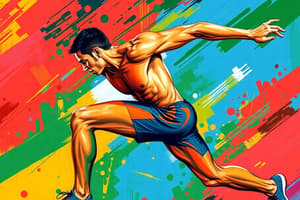Podcast
Questions and Answers
What is the primary benefit of stretching exercises?
What is the primary benefit of stretching exercises?
- Reduces body fat percentage
- Enhances metabolic rate
- Increases muscle mass
- Improves flexibility and posture (correct)
Which method provides a more accurate assessment of body composition?
Which method provides a more accurate assessment of body composition?
- Waist-to-hip ratio
- Skinfold measurements
- Body Mass Index (BMI)
- Bioelectrical impedance (correct)
Agility is most crucial for which type of activities?
Agility is most crucial for which type of activities?
- Yoga and Pilates
- Long-distance running
- Sports requiring quick direction changes (correct)
- Weightlifting
Which activity is likely to improve an individual's balance?
Which activity is likely to improve an individual's balance?
What does coordination primarily involve?
What does coordination primarily involve?
Which component of health-related fitness measures the maximum force that muscles can exert in a single effort?
Which component of health-related fitness measures the maximum force that muscles can exert in a single effort?
What is the primary focus of cardiovascular endurance?
What is the primary focus of cardiovascular endurance?
Which of the following activities would best improve muscular endurance?
Which of the following activities would best improve muscular endurance?
Which test is commonly used to assess cardiovascular endurance?
Which test is commonly used to assess cardiovascular endurance?
What does flexibility refer to in the context of physical fitness?
What does flexibility refer to in the context of physical fitness?
Flashcards are hidden until you start studying
Study Notes
Physical Fitness
- Physical fitness is the condition of being healthy, strong, and capable of performing physical activities effectively.
- It comprises components such as cardiovascular endurance, muscular strength, muscular endurance, flexibility, and body composition, all essential for overall health.
Components of Health-related Fitness
- Cardiovascular Endurance: Ability of the heart and lungs to supply oxygen during sustained physical activity; assessed through the 12-minute run test; essential for performing activities like running and swimming.
- Muscular Strength: Maximum force generated by muscles in a single effort; built through resistance exercises; crucial for heavy lifting and injury prevention.
- Muscular Endurance: Ability to sustain repeated contractions over time; important for long-duration activities like cycling and running; enables prolonged physical tasks without fatigue.
- Flexibility: Range of motion in joints; aids in injury prevention and improves posture; enhanced through stretching, yoga, and dynamic routines.
- Body Composition: Ratio of fat to lean tissue; important for reducing obesity-related disease risks; assessed using Body Mass Index (BMI) and advanced techniques like DEXA scans.
Skill-Related Components of Fitness
- Agility: Ability to change direction quickly; vital for sports like basketball and soccer; improved through drills that enhance coordination.
- Balance: Maintenance of stability; essential for activities like gymnastics and surfing; enhanced through yoga and balance exercises.
- Coordination: Smooth integration of body parts for precise movements; improved through activities challenging hand-eye or foot-eye coordination.
- Power: Combination of strength and speed for explosive movements; increased through plyometrics and Olympic lifts.
- Reaction Time: Speed of response to stimuli; improved through reaction drills for sports requiring quick reflexes.
- Speed: Ability to move quickly; important in sports like sprinting and swimming; training includes sprint intervals and resistance running.
Principles of Physical Exercise
- FITT Principle: Guidelines for effective workouts regarding frequency, intensity, time, and type; e.g., jogging several times a week at a moderate intensity.
- Overload Principle: Necessitates increasing physical demands to improve fitness; can be achieved by increasing weights or workout intensity.
- Specificity Principle: Focuses exercise on individual fitness goals; for sprinters, emphasize speed-enhancing workouts.
- Progression: Gradually increasing exercise intensity over time; consists of advancing quality or load of movements performed.
Dynamics of Dance
- Quality of Movement: Determines emotional impact; sharp movements may convey intensity, while smooth movements express grace.
- Dynamics: Variations in energy or intensity in dance, creating depth; mixes fast/slow and hard/soft movements for engagement.
- Weight: Reflects the sensation of light or heavy movements; influences the mood portrayed in performance.
- Flow: Relates to the fluidity of movement; can be continuous and free-flowing or tightly controlled.
The Body in Dance,
- Dancer's body as an instrument; understanding movement mechanics is crucial.
- Body Parts and Isolation: Isolating different body parts emphasizes emotions and skills; highlights gestures in performance.
- Shapes and Postures: Positions formed during dance communicate emotions; can range from confident to sad.
- Coordination and Balance: Seamless movement combination and stability; essential for executing complex dance routines.
Folk Dance
- Folk dances express culture and identity, passed down through generations, and often reflect community life and traditions.
Cultural Significance of Folk Dance
- Folk dances serve as storytelling mediums, encapsulating community history and cultural practices.
Famous Filipino Folk Dances
- Tinikling: Dancers navigate bamboo poles, mimicking the movements of the Tikling bird; showcases agility.
- Cariñosa: Courtship dance using fans or handkerchiefs; symbolizes romance.
- Pandanggo sa Ilaw: Dance highlighting balance and poise with oil lamps; emphasizes grace.
- Singkil: Stepping between bamboo poles, tells a story of resilience; reflects cultural heritage.
- Itik-Itik: Mimics duck movements; characterized by playful and lively steps; often performed during festivals.
Importance of Folk Dance in Preserving Culture
- Folk dances maintain cultural heritage and values, passing traditions from one generation to the next, encapsulating beliefs and customs.
Studying That Suits You
Use AI to generate personalized quizzes and flashcards to suit your learning preferences.




